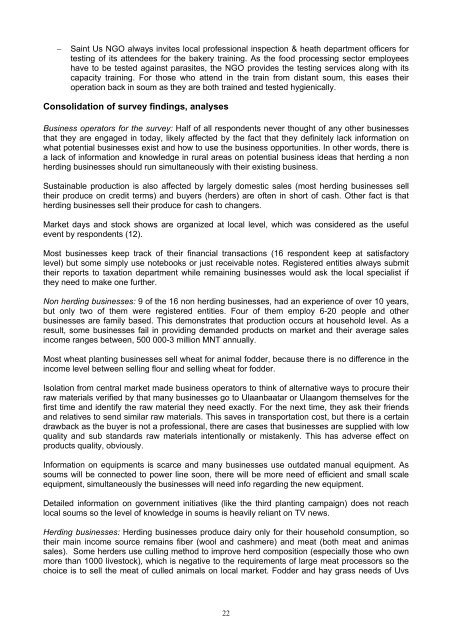BUSINESS DEVELOPMENT SERVICE ASSESSMENT REPORT
BUSINESS DEVELOPMENT SERVICE ASSESSMENT REPORT
BUSINESS DEVELOPMENT SERVICE ASSESSMENT REPORT
Create successful ePaper yourself
Turn your PDF publications into a flip-book with our unique Google optimized e-Paper software.
− Saint Us NGO always invites local professional inspection & heath department officers for<br />
testing of its attendees for the bakery training. As the food processing sector employees<br />
have to be tested against parasites, the NGO provides the testing services along with its<br />
capacity training. For those who attend in the train from distant soum, this eases their<br />
operation back in soum as they are both trained and tested hygienically.<br />
Consolidation of survey findings, analyses<br />
Business operators for the survey: Half of all respondents never thought of any other businesses<br />
that they are engaged in today, likely affected by the fact that they definitely lack information on<br />
what potential businesses exist and how to use the business opportunities. In other words, there is<br />
a lack of information and knowledge in rural areas on potential business ideas that herding a non<br />
herding businesses should run simultaneously with their existing business.<br />
Sustainable production is also affected by largely domestic sales (most herding businesses sell<br />
their produce on credit terms) and buyers (herders) are often in short of cash. Other fact is that<br />
herding businesses sell their produce for cash to changers.<br />
Market days and stock shows are organized at local level, which was considered as the useful<br />
event by respondents (12).<br />
Most businesses keep track of their financial transactions (16 respondent keep at satisfactory<br />
level) but some simply use notebooks or just receivable notes. Registered entities always submit<br />
their reports to taxation department while remaining businesses would ask the local specialist if<br />
they need to make one further.<br />
Non herding businesses: 9 of the 16 non herding businesses, had an experience of over 10 years,<br />
but only two of them were registered entities. Four of them employ 6-20 people and other<br />
businesses are family based. This demonstrates that production occurs at household level. As a<br />
result, some businesses fail in providing demanded products on market and their average sales<br />
income ranges between, 500 000-3 million MNT annually.<br />
Most wheat planting businesses sell wheat for animal fodder, because there is no difference in the<br />
income level between selling flour and selling wheat for fodder.<br />
Isolation from central market made business operators to think of alternative ways to procure their<br />
raw materials verified by that many businesses go to Ulaanbaatar or Ulaangom themselves for the<br />
first time and identify the raw material they need exactly. For the next time, they ask their friends<br />
and relatives to send similar raw materials. This saves in transportation cost, but there is a certain<br />
drawback as the buyer is not a professional, there are cases that businesses are supplied with low<br />
quality and sub standards raw materials intentionally or mistakenly. This has adverse effect on<br />
products quality, obviously.<br />
Information on equipments is scarce and many businesses use outdated manual equipment. As<br />
soums will be connected to power line soon, there will be more need of efficient and small scale<br />
equipment, simultaneously the businesses will need info regarding the new equipment.<br />
Detailed information on government initiatives (like the third planting campaign) does not reach<br />
local soums so the level of knowledge in soums is heavily reliant on TV news.<br />
Herding businesses: Herding businesses produce dairy only for their household consumption, so<br />
their main income source remains fiber (wool and cashmere) and meat (both meat and animas<br />
sales). Some herders use culling method to improve herd composition (especially those who own<br />
more than 1000 livestock), which is negative to the requirements of large meat processors so the<br />
choice is to sell the meat of culled animals on local market. Fodder and hay grass needs of Uvs<br />
22

















